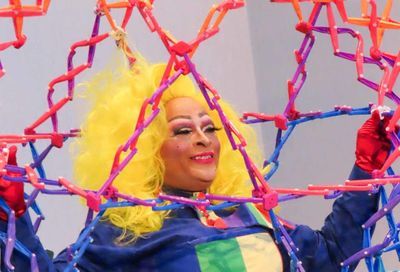‘White Noise’ Review: Panic Party
Noah Baumbach turns Don DeLillo's "unfilmable" postmodern novel into a big-budgeted, joyful surprise.

When White Noise played at the New York Film Festival, Noah Baumbach introduced the screening with some prepared remarks. After acknowledging his cast, he tipped his hat to Don DeLillo, who wrote the book on which the film is based. “I want to thank him for writing such an easily filmable book,” the director deadpanned.
Cue audience laughter. Since its publication in 1985, DeLillo’s postmodern masterpiece has widely been regarded as one of the most “unfilmable” novels in contemporary fiction. Its dense, descriptive passages; surrealist satire of American consumerism and academia; depiction of the modern supermarket as a site of spiritual communion; multilayered plots steeped in dread (“all plots tend to move deathward,” our protagonist tells us) and media oversaturation — these are not the makings of an easy page-to-screen adaptation.
That an excellent and eerily timely White Noise (★★★★☆) adaptation has finally made it to the big (well, Netflix-sized) screen is a joyful surprise. That it’s been accomplished by Baumbach, of all people, is even more unexpected.
That’s not a knock against Baumbach, who has quietly established himself as one of the best filmmakers of his generation, responsible for indie masterpieces like The Squid and the Whale (2005) and Frances Ha (2013), among other cult favorites. It’s just that Baumbach’s movies, which often satirize the dreams and squabbles of the literary class, have long been modest in budget and scale, if not emotion. And they’ve always been original screenplays, though perhaps the success of his partner Greta Gerwig’s Little Women spurred him toward wide-eyed adaptation.

The result is well outside his comfort zone: an apocalyptic disaster movie made by Baumbach instead of Michael Bay, swathed in his career-long obsessions with dysfunctional family, anxiety, academia, and Adam Driver’s cheekbones. Even as he blows his ambitions up to scale, crafting a film outfitted with a high-octane car chase, a near-biblical explosion, a Danny Elfman score, and all the other things an $80 million budget can get you, Baumbach remains preoccupied with the fears of death, aging, and abandonment that have defined much of his work.
The filmmaker is anchored by his loyal collaborators. Driver, more schlubby and disheveled than usual, stars as Jack Gladney, a well-respected professor who pioneered the field of Hitler Studies at the College-on-the-Hill, despite his embarrassing secret that he cannot speak German. Jack and his fourth wife, Babette (a poodle-haired Gerwig — did I mention this is set in the eighties?), share a blended family, with four brainy children between them.
They also share a debilitating fear of mortality; their pillow talk is morbid, with spirited debates about which partner will die first. Meanwhile, Babette spends her days teaching fitness classes and popping a mysterious pill called Dylar.
Their lives are thrown into disarray when a chemical spill from a train disaster causes a dangerous black cloud known as the “Airborne Toxic Event.” Panicking about the health threat, they evacuate to a post-apocalyptic encampment of sorts. Jack is briefly exposed to the black cloud while pumping gas and comes to believe that he’s slowly dying. Is he? Well, aren’t we all?
Ah, but who cares about plot? Here is where Baumbach indulges his untapped disaster-movie muscle. In collaboration with cinematographer Lol Crawley (Vox Lux), he pays homage to Spielberg, filling the screen with Close Encounters of the Third Kind-inspired shots of highways illuminated by dark skies alight with secrets.
This ominous stretch of the movie resonates today in ways it wouldn’t have in 1985. Baumbach deftly emphasizes the mounting confusion and dread triggered by the Airborne Toxic Event, which parallels the early weeks of COVID — that strange vacillating between denial and utter panic. At a time when most great directors avoid acknowledging the pandemic onscreen like it’s, well, the plague, Baumbach has found a way in.
“Welcome back, shoppers,” intones a supermarket employee after the acute crisis is over (sound familiar?). While DeLillo’s book lampooned cultural sickness, this adaptation also invokes our literal sickness.
Even as he takes liberties with the novel’s plot (and omits a major symbol of popular artifice, the “most photographed barn in the world”), Baumbach is faithful to the overriding sense of paranoia and pitch-black comedy. He has clearly inherited DeLillo’s dark humor and love of language. Consider the recurring gag of Jack’s futile attempts to learn German, or the semantic bickerings over what to call that scary black cloud.
Driver navigates the film’s jarring tonal shifts and is hypnotic in a scene that requires him to summon Hitler’s frightening charisma while lecturing on the Nazi dictator. Don Cheadle, who plays his colleague Murray, delivers much of the comic relief.
It is Baumbach’s most visually striking movie by far. Consider the supermarket sequences, the finest supermarket cinematography this side of The Big Lebowski. DeLillo’s novel emphasized the grocery store as a spiritual gateway, a sort of temple for the characters — consumerism as religion, with its own rituals and symbols. Baumbach films the garishly colored aisles of the supermarket the way John Ford once filmed the rugged terrain of the West. Real brand names and logos illuminate every frame: L’eggs, Hi-C, Doritos.
Joe Dante’s cartoonish sensibility comes to mind. The kitsch and artifice is the point.
While many of his contemporaries either stay in their lanes or go big only within the dismal Marvel movie mold, it’s exhilarating to see Baumbach swing for the fences with something as downright weird and polarizing as White Noise.
The third act veers into Lynchian surrealism as Jack confronts the hallucinatory man who’s been plying Babette with the drug known as Dylar. At times, it’s too much, too messy, over-reliant on Elfman’s sweeping score to inject suspense; significant plot points remain unexplained. Yet the film is never dull.
Given recent reports about a cash-strapped Netflix putting the brakes on expensive prestige projects, Baumbach may never get this kind of carte blanche again. Perhaps White Noise will someday be remembered as the end of the Netflix auteur era, just as Heaven’s Gate and One From the Heart signaled the messy demise of the New Hollywood era. Or maybe I’m just paranoid about death, too.
White Noise is streaming on Netflix. Visit www.netflix.com.
Support Metro Weekly’s Journalism
These are challenging times for news organizations. And yet it’s crucial we stay active and provide vital resources and information to both our local readers and the world. So won’t you please take a moment and consider supporting Metro Weekly with a membership? For as little as $5 a month, you can help ensure Metro Weekly magazine and MetroWeekly.com remain free, viable resources as we provide the best, most diverse, culturally-resonant LGBTQ coverage in both the D.C. region and around the world. Memberships come with exclusive perks and discounts, your own personal digital delivery of each week’s magazine (and an archive), access to our Member's Lounge when it launches this fall, and exclusive members-only items like Metro Weekly Membership Mugs and Tote Bags! Check out all our membership levels here and please join us today!

























You must be logged in to post a comment.